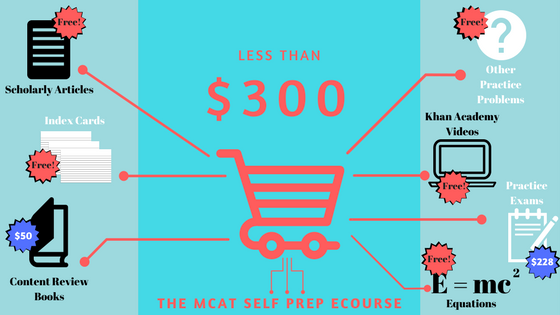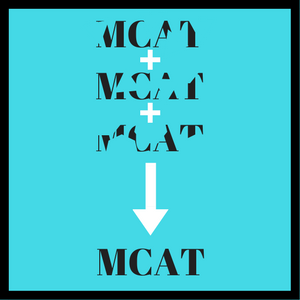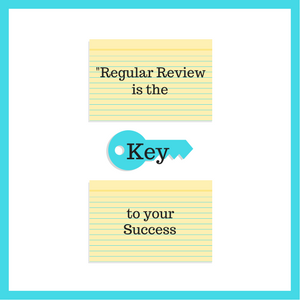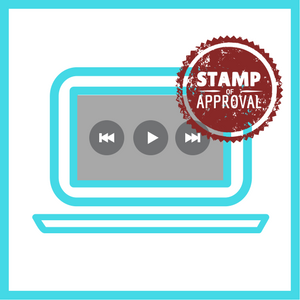
Many MCAT prep companies will try to sell you on the idea that you need to spend thousands and thousands of dollars on a fancy prep course with all its bells and whistles in order to get a top score on the MCAT, but this just isn’t the case. We carefully analyzed the experiences of students that scored above the 95th percentile on the MCAT and looked for patterns in their preparation, and our analysis revealed that the students who performed well weren’t  necessarily the students who spent the most money on a prep course. In actuality, top scorers use a variety of low-cost resources. And this actually makes perfect sense. Think about it. Every MCAT prep company has a single (likely slightly inaccurate) perspective regarding the most important concepts to know for the MCAT. By preparing using a variety of materials, you will gain several perspectives on the material, which when combined together provide you with a much more accurate picture of the MCAT.
necessarily the students who spent the most money on a prep course. In actuality, top scorers use a variety of low-cost resources. And this actually makes perfect sense. Think about it. Every MCAT prep company has a single (likely slightly inaccurate) perspective regarding the most important concepts to know for the MCAT. By preparing using a variety of materials, you will gain several perspectives on the material, which when combined together provide you with a much more accurate picture of the MCAT.
For this reason, we advise our students to utilize a variety of only the best MCAT prep materials, many of which are actually free! In fact, you should be able to get all of these materials for less than a few hundred dollars. Here is our list of the 7 best MCAT prep materials:
1. AAMC Practice Exams and Practice Questions. The best way to practice is to practice on the real thing, and the AAMC practice materials are as close as you can get. You should do at least 5 to 15 AAMC practice questions a day from the day you start studying for the MCAT until the day that you take the exam (unless your MCAT date is more than a year away of course). Something to keep in mind is that you should slowly increase the amount of practice problems and decrease the amount of content review over time. This way, you will build up your content knowledge first before investing tons of time and effort into doing practice problems. Thus, the practice problems will be fresh on your mind come test day. At the same time, however, you shouldn’t try to cram all the practice problems in right before you take the MCAT because doing them while you are learning content helps you know what information is important and what information is not. The AAMC has a bundle which gives you a little over 2,000 practice problems for only $228. Remember that the access code only lasts one year, so don’t buy this resource more than a year before your MCAT test date.
2. Notecards. For many college exams you can often get an A by cramming the night before and then forgetting it as soon as the exam is over. I’m sorry, but this approach won’t work for the MCAT. The MCAT covers so much material that by the time you finish learning everything, you have already forgotten the first 3/4ths of the material. A system of regular review is the  key to your success. By using notecards to regularly review what you have learned, you will be able to keep every piece of information at the forefront of your mind. Some people like paper notecards because they are versatile for drawing pictures and diagrams, while others prefer using an electronic option such as Quizlet. With Quizlet, you can easily add pictures to the notecards you create as well as study on the go with the Quizlet mobile app! And best of all, Quizlet is free!
key to your success. By using notecards to regularly review what you have learned, you will be able to keep every piece of information at the forefront of your mind. Some people like paper notecards because they are versatile for drawing pictures and diagrams, while others prefer using an electronic option such as Quizlet. With Quizlet, you can easily add pictures to the notecards you create as well as study on the go with the Quizlet mobile app! And best of all, Quizlet is free!
3. Khan Academy Videos. The AAMC put their seal of approval on the MCAT video collection completed by Khan Academy. For this reason, the collection should be fairly on par with the content that the creators of the exam expect you to know. That being said, there is still content on the MCAT not contained in the Khan Academy video collection, but this may be the closest you can get. One great thing about the video collection is that you can watch it at 2x the speed and pause it as often as you’d like. And the best thing about this video collection is that it is absolutely free!
4. Another Content Review Book. Although Khan  Academy is the only content resource that has been endorsed by the AAMC, you would be lacking if you only watched the Khan Academy videos because the MCAT tests you on your general fluency in science. In order to become fluent in science, you will want to have heard each science topic covered from several different perspectives. For instance, if you learn about glycolysis from your college-level biochemistry course, the Khan Academy videos, and from a content review book you should be feeling fairly well versed in glycolysis. If you were to only hear about it from one perspective, however, you would be lacking. Our research has shown both the Kaplan MCAT Complete 7-book Subject Review and the Princeton Review MCAT Subject Review Complete Box Set to be two of the best content books out there. Not only do they thoroughly review almost every MCAT concept, they also grant you access to several practice exams. For instance, the Kaplan content review book comes with access to three. Granted, they aren’t the best practice exams since they aren’t produced by the AAMC, but they still help you develop stamina for test day. Don’t feel like you need to buy the most recent edition of the book though. There typically isn’t very much variation between editions. If it was produced within the last few years and was made for the new 2015 MCAT, you should be fine. When buying a used book, though, be aware that you may not get access to the accompanying practice exams. All in all, this part could cost you anywhere between $50 and $150 per content review book.
Academy is the only content resource that has been endorsed by the AAMC, you would be lacking if you only watched the Khan Academy videos because the MCAT tests you on your general fluency in science. In order to become fluent in science, you will want to have heard each science topic covered from several different perspectives. For instance, if you learn about glycolysis from your college-level biochemistry course, the Khan Academy videos, and from a content review book you should be feeling fairly well versed in glycolysis. If you were to only hear about it from one perspective, however, you would be lacking. Our research has shown both the Kaplan MCAT Complete 7-book Subject Review and the Princeton Review MCAT Subject Review Complete Box Set to be two of the best content books out there. Not only do they thoroughly review almost every MCAT concept, they also grant you access to several practice exams. For instance, the Kaplan content review book comes with access to three. Granted, they aren’t the best practice exams since they aren’t produced by the AAMC, but they still help you develop stamina for test day. Don’t feel like you need to buy the most recent edition of the book though. There typically isn’t very much variation between editions. If it was produced within the last few years and was made for the new 2015 MCAT, you should be fine. When buying a used book, though, be aware that you may not get access to the accompanying practice exams. All in all, this part could cost you anywhere between $50 and $150 per content review book.
5. Other Practice Problems. As mentioned earlier, practice exams produced by anyone other than the AAMC are often subpar. They also give you a terribly inaccurate measure of how well you are doing. In fact, many students report getting MCAT scores 10 to 15 points higher than their score on a third-party (non-AAMC) practice exam. Despite their flaws, they are helpful in simulating the test day situation. On test day, there will be at least a few questions that you look at and think, “What! Since when was that part of the MCAT content!?” Seriously, it will happen. But, don’t freak out. Remember, everyone is taking the same test. Taking MCAT exams that are not true to the AAMC standard will help you feel comfortable when you encounter questions that seem out of place on test day. There is no need to spend much extra money on these other practice problems. Here is a list of other practice problems in order of usefulness:
• Testing Solutions. If you need extra help with the CARS (Critical Analysis and Reasoning) section, Testing Solutions is perfect for you. They have a free 30-day guide to the CARS, which will walk you through CARS strategies in a step-by-step manner. They also have CARS practice exams available for about $5 each!
• Kaplan. As previously mentioned, the Kaplan 7-book Series comes with three practice exams. Kaplan also offers a free half-length exam.
• Exam Krackers. Exam Krackers has received good reviews from several top scorers, but they offer relatively few free practice problems and their materials are relatively expensive ($50 per practice exam).
• Princeton Review. Princeton Review’s content book comes with three practice exams. Also, Princeton Review has a free online practice exam, and you can buy 4 practice exams from The Princeton Review for around $50 if you really need more practice.
• Next Step. Next Step offers a free full-length and a free half-length practice exam. They also sell extra exams for around $25 each.
• Altius. Altius offers a free half-length exam.
• Gold Standard. Gold Standard offers a free 1/3rd length exam.
• Khan Academy. Khan Academy has hundreds of practice passages as well. As mentioned previously, there is no reason to spend a single penny on practice exams unless you really feel like you are wanting more practice. However, many students report that they are very dissimilar to the AAMC question format and test you on content that is outside the scope of the MCAT.
• Varsity tutors. Varsity Tutors offers thousands of free practice questions, some of which are in an exam-like format. Like the Khan Academy practice problems, though, they are not of the highest quality.
6. Equations. The AAMC doesn’t outline exactly what equations you need to memorize and which ones will be provided to you on test day. But, as you do more and more practice problems, you will get a pretty good feel for what level of equation the MCAT will expect you to have in your tool belt.  For instance, F = ma is definitely an equation you should have completely memorized. This next equation? dF = dq v(B sin α) = I dl(B sin α). Unlikely. While you are preparing for the MCAT, just try as hard as you can to memorize the easy equations and simply understand the more difficult ones.
For instance, F = ma is definitely an equation you should have completely memorized. This next equation? dF = dq v(B sin α) = I dl(B sin α). Unlikely. While you are preparing for the MCAT, just try as hard as you can to memorize the easy equations and simply understand the more difficult ones.
7. Scholarly Articles and Journals. Many top scorers on the MCAT will tell you that the MCAT is more of a critical reading test than anything. If you memorize all the information but fail to learn how to read and understand scholarly pieces of literature, you may very well struggle to get a high score. For this reason, you should read as often as you can. Although “sciency” articles are preferable, the important thing is to read, and read a lot. Even if your passion is reading Twilight, go for it. Just read as much as you can.
So, there you have it, the 7 most essential MCAT prep materials all for less than a few hundred dollars.

Comments are closed.